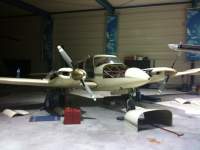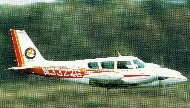I too use the Larry Larkin numbers. I use MPH for flying, but since everyone is talking Knots I'll convert to Knots here to be consistent.
For approach, that's 2400 RPM (usually untouched from cruise) and 19" of MP (my airplane is a Robertson, so it's a little draggier down low). Usually as I descend from cruise I gradually bring the MP back to 19" and then leave it there. When I level off before glideslope intercept the airplane will decelerate to 120 KTS with flaps up. I leave things alone and just put the gear down at Glideslope intercept. She slides down smooth as can be at 120.
If I break out at 500 feet AGL or higher, then I pull the power back and put the flaps down as the airplane decelerates. Depending on weight I aim to cross the fence at between 73 and 76 KTS (remember, my airplane is a Robertson). If it's a full on low approach at "200 and a half", then I leave the flaps up and cross the fence at 80 to 85 KTS.
There was a rather extensive debate on either this forum or Delphi about approach speeds. Some advocated the Larkin approach, others were set on slowing to 90 KTS and putting the flaps down so that the airplane is completely stabilized in the landing configuration. Some also felt that 120 KTS is too fast to be flying an approach in a Comanche.
There is a good argument for flying a stabilized approach, and some advocate following airline procedures and not making any configuration changes below 1,000 feet. Personally, I think that we are flying simple, relatively forgiving airplanes and that a competent Comanche pilot should be able to fly the approach at 120, but that's my opinion.
VFR pattern I use 15" MP abeam the numbers and she slows nicely to cross the fence at about 73 KTS (adjusting power as required to control rate of descent).
Best to just experiment in your own airplane and find what works for you.
Jay
What speeds do you use for your Twinkie ?
19 posts
• Page 1 of 2 • 1, 2
What speeds do you use for your Twinkie ?
- Attachments
-
 Pattern.pdf
Pattern.pdf- (66.41 KiB) Downloaded 206 times
-

ComBE - ICS member

- Posts: 80
- Joined: Sat Sep 13, 2008 11:20 am
- Location: Brussels - PA39 serial 66
- Attachments
-
 Comanche Approach Speeds.pdf
Comanche Approach Speeds.pdf- (1.55 MiB) Downloaded 193 times
- MULEFLY
- ICS member

- Posts: 900
- Joined: Tue Jan 25, 2000 1:34 am
- Location: Wisconsin
I use the Larry Larkin numbers and since you posted in MPH, I'll respond in mph.
VFR Pattern
at 10 miles out I run the checklist and make sure the fuel is on mains and fuel pumps on - I audible so my co-pilot knows also.
2400 RPM and slowly bring mp from 24 " down to 17" which used to give me 140 mph, nice gear down speed but since I upgraded the flexible baffles, I now use 16 " and gets the twin at 140 mph. At mid-field crosswind or entering downwind, I drop the gear which now brings it down to flap speed.
I drop flaps to 2/3 and the Twin is now at a nice 105 mph so heaven forbid, an engine dies, I have best single engine rate of climb.
At base at about 500' AGL, I judge the wind and distance to the airport and reduce power.
At final I again judge the airport distance and when I'm sure I can make it, add full flaps and trim up to 90 mph over the fence and reduce power as needed. I audible gear down and check the gear light, props full and mixture set.
When over the runway, I quit watching the airspeed indicator and use the runway to gauge the correct attitude.
When fitting in with 172s, I use the same speeds but a bigger pattern.
I'll post the Larkin IFR approach recommendations in the next day or so and they match some of the above postings. Given we are based under Class B DFW busy airspace, Approach often requests/dictates what speed we are flying so 150kts to fit in with their traffic is not unusual up to the Final Approach Fix.
VFR Pattern
at 10 miles out I run the checklist and make sure the fuel is on mains and fuel pumps on - I audible so my co-pilot knows also.
2400 RPM and slowly bring mp from 24 " down to 17" which used to give me 140 mph, nice gear down speed but since I upgraded the flexible baffles, I now use 16 " and gets the twin at 140 mph. At mid-field crosswind or entering downwind, I drop the gear which now brings it down to flap speed.
I drop flaps to 2/3 and the Twin is now at a nice 105 mph so heaven forbid, an engine dies, I have best single engine rate of climb.
At base at about 500' AGL, I judge the wind and distance to the airport and reduce power.
At final I again judge the airport distance and when I'm sure I can make it, add full flaps and trim up to 90 mph over the fence and reduce power as needed. I audible gear down and check the gear light, props full and mixture set.
When over the runway, I quit watching the airspeed indicator and use the runway to gauge the correct attitude.
When fitting in with 172s, I use the same speeds but a bigger pattern.
I'll post the Larkin IFR approach recommendations in the next day or so and they match some of the above postings. Given we are based under Class B DFW busy airspace, Approach often requests/dictates what speed we are flying so 150kts to fit in with their traffic is not unusual up to the Final Approach Fix.
Last edited by N3322G on Wed Mar 10, 2010 7:52 pm, edited 1 time in total.
Pat
Patricia Jayne (Pat) Keefer ICS 08899
PA-39 #10 Texas
Patricia Jayne (Pat) Keefer ICS 08899
PA-39 #10 Texas
-

N3322G - ICS member

- Posts: 1911
- Joined: Thu May 08, 2008 1:58 pm
- Location: Fort Worth, Texas area
19 posts
• Page 1 of 2 • 1, 2
Return to Maintenance - Airframe
Who is online
Users browsing this forum: No registered users and 0 guests
